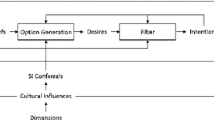Abstract
Integrating culture into the behavioural models of virtual characters requires knowledge from very different disciplines such as cross-cultural psychology and computer science. If culture-related behavioural differences are simulated with a virtual character system, users might not necessarily understand the intent of the designer. This is, in part, due to the influence of culture on not only users, but also designers. To gain a greater understanding of the instantiation of culture in the behaviour of virtual characters, and on this potential mismatch between designer and user, we have conducted two experiments. In these experiments, we tried to simulate one dimension of culture (Masculinity vs. Femininity) in the behaviour of virtual characters. We created four scenarios in the first experiment and six in the second. In each of these scenarios, the same two characters interact with each other. The verbal and non-verbal behaviour of these characters differs depending on their cultural scripts. In two user perception studies, we investigated how these differences are judged by human participants with different cultural backgrounds. Besides expected differences between participants from Masculine and Feminine countries, we found significant differences in perception between participants from Individualistic and Collectivistic countries. We also found that the user’s interpretation of the character’s motivation had a significant influence on the perception of the scenarios. Based on our findings, we give recommendations for researchers that aim to design culture-specific behaviours for virtual characters.

Similar content being viewed by others
References
Aylett R, Vannini N, Andre E, Paiva A, Enz S, Hall L (2009) But that was in another country: agents and intercultural empathy. In: Proceedings of 8th international conference on autonomous agents and multi agent systems. International Foundation for Autonomous Agents and Multiagent Systems, Budapest, Hungary, pp 10–15. Retrieved from http://dl.acm.org/citation.cfm?id=1558058
Byrne D (1971) The attraction paradigm. Academic, New York, p 474
Damian I, Endrass B, Huber P, Bee N, Andre E (2011) Individualized agent interactions. In: Proceedings of the 4th international conference on motion in games, pp 15–26
Endrass B, André E, Rehm M, Lipi AA, Nakano Y (2011a) Culture-related differences in aspects of behavior for virtual characters across Germany and Japan. In: Proceedings of the 10th international conference on autonomous agents and multiagent systems, pp 441–448
Endrass B, Rehm M, André E (2011b) Planning small talk behavior with cultural influences for multiagent systems. Comp Speech Lang 25(2):158–174
Hofstede GJ, Pedersen P, Hofstede G (2002) Exploring culture: exercises. Nicholas Brealey Publishing, Stories and Synthetic Cultures
Hofstede G, Hofstede GJ, Minkov M (2010) Cultures and organizations: software of the mind: intercultural cooperation and its importance for survival. McGraw-Hill, New York
Jan D, Herrera D, Martinovski B, Novick D, Traum D (2007) A computational model of culture-specific conversational behavior. In: Proceedings of 7th international conference on intelligent virtual agents. Springer, Berlin. doi:10.1007/978-3-540-74997-4_5
Johnson WL, Valente A (2008) Tactical language and culture training systems: using artificial intelligence to teach foreign languages and cultures. In: Proceedings of 20th national conference on innovative applications of artificial intelligence. AAAI Press, Chicago, Illinois
Johnson WL, Marsella S, Vilhjálmsson H (2004) The DARWARS tactical language training system. In: Interservice/industry training, simulation and education conference, pp 1–11
Kim JM, Hill RW, Durlach PJ, Lane HC, Forbell E, Core MG, Marsella SC, Pynadath D, Hart J (2009) BiLAT: a game-based environment for practicing negotiation in a cultural context. Int J Artif Intell Educ 19:289–308
Koda T, Rehm M, André E (2008) Cross-cultural evaluations of avatar facial expressions designed by western designers. In: Proceedings of 8th international conference on intelligent virtual agents, pp 245–252
Koda T, Ruttkay Z, Nakagawa Y, Tabuchi K (2010) Cross-cultural study on facial regions as cues to recognize emotions of virtual agents. Cult Comput 6259:16–27
Luft J (1970) The Johari Window: a graphical model of awareness in interpersonal relations. In: Group processes: an introduction to group dynamics. National Press Books, Palo Alto, pp 11–20
Mascarenhas SF, Dias J, Afonso N, Enz S, Paiva A (2009) Using rituals to express cultural differences in synthetic characters. In: Proceedings of 8th international conference on autonomous agents and multi agent systems. International Foundation for Autonomous Agents and Multiagent Systems, Budapest, Hungary
Smith PB (2006) When elephants fight, the grass gets trampled: the GLOBE and Hofstede projects. J Int Bus Stud 37(6):915–921
Acknowledgments
This work was partially supported by European Community (EC) and was funded by the ECUTE (ICT-5-4.2 257666) project. The authors are solely responsible for the content of this publication. It does not represent the opinion of the EC or the FCT, which are not responsible for any use that might be made of data appearing therein. We would like to thank John Mc Breen for proofreading the article.
Author information
Authors and Affiliations
Corresponding author
Rights and permissions
About this article
Cite this article
Degens, N., Endrass, B., Hofstede, G.J. et al. ‘What I see is not what you get’: why culture-specific behaviours for virtual characters should be user-tested across cultures. AI & Soc 32, 37–49 (2017). https://doi.org/10.1007/s00146-014-0567-2
Received:
Accepted:
Published:
Issue Date:
DOI: https://doi.org/10.1007/s00146-014-0567-2




